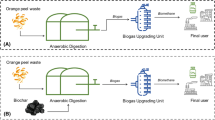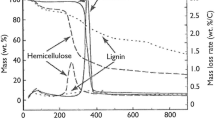Abstract
The advantages of biochar application in crop production, water treatment and more are well known; however, the manufacturing cost (roughly 500USD t−1) prevents its expansion into the commercial scale. The very first apparatus which continuously produces the biochar from the fermentation residue by utilizing waste heat from the cogeneration unit linked to the biogas station was designed and analyzed. The manifestations of the pyrolysis retention time and the operating temperature were studied in detail. The results supported by corresponding financial analysis show that the biochar obtained had sufficient quality, and the concept may be economically viable once the cost may be negligible in a long term.


Similar content being viewed by others
References
Biederman LA, Harpole WS (2013) Biochar and its effects on plant productivity and nutrient cycling: a meta-analysis. GCB Bioenerg 5:202–214
Busch D, Kammann C, Grünhage L, Müller C (2012) Simple biotoxicity tests for evaluation of carbonaceous soil additives: establishment and reproducibility of four test procedures. J Environ Qual 41:1023–1032
Fabbri D, Rombolà AG, Torri C, Spokas KA (2013) Determination of polycyclic aromatic hydrocarbons in biochar and biochar amended soil. J Anal Appl Pyrol 103:60–67
Gaskin JW, Steiner C, Harris K, Das KC, Bibens B (2008) Effect of low-temperature pyrolysis conditions on biochar for agricultural use. Trans ASABE 51:2061–2069
Hale SE, Lehmann J, Rutherford D, Zimmerman AR, Bachmann RT, Shitumbanuma V, O’Toole A, Sundqvist KL, Arp HP, Cornelissen G (2012) Quantifying the total and bioavailable polycyclic aromatic hydrocarbons and dioxins in biochars. Environ Sci Technol 46:2830–2838
Hašková S, Kolář P (2010) A contribution to a mathematic modeling of the behavior of private and institutionalized investors as observed in practice. 28th International Conference on Mathematical Methods in Economics: 214–219
Hašková S, Kolář P (2011) The mathematic modeling of process economization of natural resources. 29th International Conference on Mathematical Methods in Economics: 224–229
Hašková S, Kolář P (2012). Determination of mutually acceptable price of used manufacturing equipment. 30th International Conference on Mathematical Methods in Economics: 266–271
Hašková S, Kolář P (2013) The Limits of Relativism in Managerial Thinking. 31th International Conference on Mathematical Methods in Economics: 153–161
Jeffery S, Verheijen FGA, van der Velde M, Bastos AC (2011) A quantitative review of the effects of biochar application to soils on crop productivity using meta-analysis. Agric Ecosyst Environ 144:175–187
Kahraman C, Ruan D, Tolga E (2002) Capital budgeting techniques using discounted fuzzy versus probabilistic cash flows. Inf Sci 142:57–76
Kehres B, Th elen-Jüngling M, Bidlingmaier W, Meyer-Spasche H, Fischer P, Philipp W, Marciniszyn E, Schneichel H-W, Severin K, Müller M (2006) Methodenbuch zur Analyse organischer Düngemittel, Bodenverbesserungsmittel und Substrate. (Method handbook for analysis of organic fertilizers, soil ameliorants and substrates.). BundesgütegemeinschaftKompost e.V, Köln-Gremberghoven
Kolář L, Kužel S, Peterka J, Štindl P, Plát V (2008) Agrochemical value of the organic matter of fermenter wastes in biogas production. Plant Soil Environ 54:321–328
Kowalenko G (2001) Assessment of Leco CNS-2000 analyzer for simultaneously measuring total carbon, nitrogen, and sulphur in soil. Commun Soil Sci Plan 32:2065–2078
Lehmann J, Joseph S (2009) Biochar for environmental management: science and technology. Earthscan, London
Lehmann J, Rillig MC, Thies J, Masiello CA, Hockaday WC, Crowley D (2011) Biochar effects on soil biota: a review. Soil Biol Biochem 43:1812–1836
Libra JA, Ro KS, Kammann C, Funke A, Berge ND, Neubauer Y, Titirici M-M, Fühner C, Bens O, Kern J, Emmerich K-H (2011) Hydrothermal carbonization of biomass residuals: a comparative review of the chemistry, processes and applications of wet and dry pyrolysis. Biofuels 2:71–106
Liu XY, Zhang AF, Ji CY, Joseph S, Bian RJ, Li LQ, Pan GX, Paz-Ferreiro J (2013) Biochar’s effect on crop productivity and the dependence on experimental conditions: a meta-analysis of literature data. Plant Soil 373:583–594
Marlier E, Natali D, Van Dam R (2010) Europe 2020, towards a more social EU? Series: Travail & Société/Work & Society. Peter Lang, Wien
Maroušek J (2013) Prospects in straw disintegration for biogas production. Environ Sci Pollut R 20:7268–7274
Maroušek J, Kawamitsu Y, Ueno M, Kondo Y, Kolar L (2012) Methods for improving methane yield from rye straw. Appl Eng Agric 28:747–755
Nelson W (1981) Analysis of performance-degradation data. IEEE Trans Reliab 2:149–155
Novak JM, Watts DW (2013) Augmenting soil water storage using uncharred switchgrass and pyrolyzed biochars. Soil Use Manag 29:98–104
Novak JM, Lima I, Xing B, Gaskin JW, Steiner C, Das KC, Ahmedna M, Rehrah D, Watts DW, Busscher WJ, Schomberg H (2009) Characterization of designer biochar produced at different temperatures and their effects on a loamy sand. Ann Environ Sci 3:195–206
Shackley S, Sohi S (eds) (2010) An assessment of the benefits and issues associated with the application of biochar to soil. A report commissioned by the United Kingdom Department for Environment, Food and Rural Affairs, and Department of Energy and Climate Change. UK Biochar Research Centre, Edinburgh
Smetanová A, Dotterweich M, Diehl D, Ulrich U, Fohrer N (2013) Influence of biochar and terra preta substrates on wettability and erodibility of soils. Zeitschrift für Geomorphologie 57:111–134 Supplementary Issues
Spokas KA (2010) Review of the stability of biochar in soils: predictability of O: C molar ratios. Carbon Manag 1:289–303
Vaccari FP, Baronti S, Lugato E, Genesio L, Castaldi S, Fornasier F, Miglietta F (2011) Biochar as a strategy to sequester carbon and increase yield in durum wheat. Eur J Agron 34:231–238
Woolf D, Amonette JE, Street-Perrott FA, Lehmann J, Joseph S (2010) Sustainable biochar to mitigate global climate change. Nat Commun 1:1–9
Author information
Authors and Affiliations
Corresponding author
Rights and permissions
About this article
Cite this article
Maroušek, J. Significant breakthrough in biochar cost reduction. Clean Techn Environ Policy 16, 1821–1825 (2014). https://doi.org/10.1007/s10098-014-0730-y
Received:
Accepted:
Published:
Issue Date:
DOI: https://doi.org/10.1007/s10098-014-0730-y




